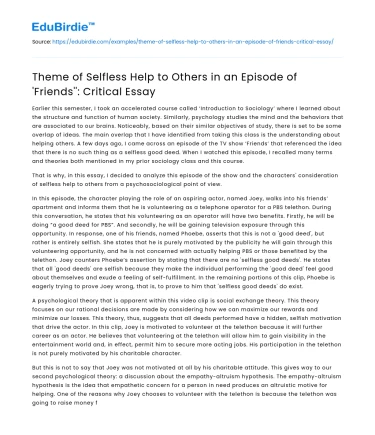Earlier this semester, I took an accelerated course called ‘Introduction to Sociology’ where I learned about the structure and function of human society. Similarly, psychology studies the mind and the behaviors that are associated to our brains. Noticeably, based on their similar objectives of study, there is set to be some overlap of ideas. The main overlap that I have identified from taking this class is the understanding about helping others. A few days ago, I came across an episode of the TV show ‘Friends’ that referenced the idea that there is no such thing as a selfless good deed. When I watched this episode, I recalled many terms and theories both mentioned in my prior sociology class and this course.
That is why, in this essay, I decided to analyze this episode of the show and the characters' consideration of selfless help to others from a psychosociological point of view.
Save your time!
We can take care of your essay
- Proper editing and formatting
- Free revision, title page, and bibliography
- Flexible prices and money-back guarantee
In this episode, the character playing the role of an aspiring actor, named Joey, walks into his friends’ apartment and informs them that he is volunteering as a telephone operator for a PBS telethon. During this conversation, he states that his volunteering as an operator will have two benefits. Firstly, he will be doing “a good deed for PBS”. And secondly, he will be gaining television exposure through this opportunity. In response, one of his friends, named Phoebe, asserts that this is not a 'good deed', but rather is entirely selfish. She states that he is purely motivated by the publicity he will gain through this volunteering opportunity, and he is not concerned with actually helping PBS or those benefited by the telethon. Joey counters Phoebe’s assertion by stating that there are no 'selfless good deeds'. He states that all 'good deeds' are selfish because they make the individual performing the 'good deed' feel good about themselves and exude a feeling of self-fulfillment. In the remaining portions of this clip, Phoebe is eagerly trying to prove Joey wrong, that is, to prove to him that 'selfless good deeds' do exist.
A psychological theory that is apparent within this video clip is social exchange theory. This theory focuses on our rational decisions are made by considering how we can maximize our rewards and minimize our losses. This theory, thus, suggests that all deeds performed have a hidden, selfish motivation that drive the actor. In this clip, Joey is motivated to volunteer at the telethon because it will further career as an actor. He believes that volunteering at the telethon will allow him to gain visibility in the entertainment world and, in effect, permit him to secure more acting jobs. His participation in the telethon is not purely motivated by his charitable character.
But this is not to say that Joey was not motivated at all by his charitable attitude. This gives way to our second psychological theory: a discussion about the empathy-altruism hypothesis. The empathy-altruism hypothesis is the idea that empathetic concern for a person in need produces an altruistic motive for helping. One of the reasons why Joey chooses to volunteer with the telethon is because the telethon was going to raise money for youth in need. He states that by volunteering as a phone operator and taking donations over the telephone, he will be performing a good deed for children in need.
And the third psychological theory arises from Phoebe's character in this clip. This theory is called the negative state relief model. This term proposes that people help others in order to counteract their own feelings and make them feel good about themselves. In this clip, Phoebe perceives herself as someone who does in-fact perform good deeds purely because they are ‘good’, not because these acts will benefit her in some way. This perception of herself is developed after she hears Joey state that “there are no selfless good deeds” and that every good deed performed by an individual is performed with selfish intentions. Phoebe completely disagrees with the idea that one helps others just to make themselves feel better, or the negative state relief model. In the remainder of the clip, she intends to prove that she is in fact an individual who performs good deeds purely for the benefit of others, rather than for her own self-interest.
As this analysis has shown, the topic of helping others is relevant and controversial and is covered even in popular TV shows. In this case, an episode of ‘Friends’, the theme of helping others and its selflessness is depicted through social exchange theory, the empathy-altruism hypothesis, and the negative state relief model. The knowledge I received from the course and the analysis with their help of the episode of the show gave me a deeper understanding of the topic of helping others and formed my own vision of it.






 Stuck on your essay?
Stuck on your essay?

